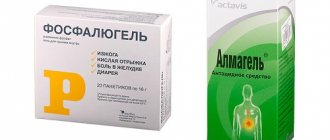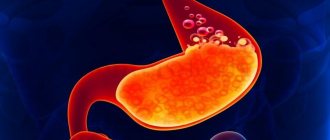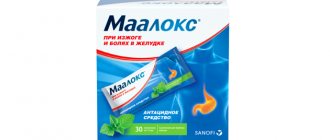The article was prepared by a specialist for informational purposes only. We urge you not to self-medicate. When the first symptoms appear, consult a doctor.
Antacids are medications that are designed to neutralize the acid produced in the human stomach. Modern pharmacology offers a wide selection of medicines that have different release forms.
When should you take antacids?
Antacids are prescribed to get rid of heartburn, which is a companion to many diseases of the digestive tract, including: stomach ulcers, reflux esophagitis, functional dyspepsia, etc.
In past years, antacids were widely used to treat various pathologies of the digestive system. However, the discovery of proton pump inhibitors and H2 receptor blockers, these drugs faded into the background. Modern drugs not only temporarily neutralize increased stomach acidity, but also reduce acid production, and they act for quite a long time.
However, antacids were not forgotten. Their advantage is the high speed with which they begin to act. In addition, antacids have a lower cost compared to proton pump drugs and H2 blockers.
Contraindications and restrictions for use
The list of contraindications to the use of antacid drugs is small. First of all, it is necessary to exclude:
- allergic reaction to drug components,
- clinically and functionally significant impairment of renal function,
- Alzheimer's type dementia.
In some cases, some antacids are contraindicated for lactating and pregnant patients. The use of antacids should be carefully regulated for children of different ages and patients with impaired macronutrient metabolism (increased levels of calcium, magnesium), impaired absorption of fructose, glucose and galactose.
How antacids work
The stomach needs acid so that it can digest food. It is a very caustic substance, but it does not corrode the gastric walls, since they are covered with a special mucous layer. It is this that protects the stomach from the destructive effects of acid and prevents erosions and ulcers from forming.
However, sometimes the mucous membrane is damaged due to various circumstances, which gives acid access to the walls of the stomach, and it begins to corrode them. As a result, a person develops an ulcer. When the sphincter, which is a natural partition between the stomach and esophagus, weakens, acid can be thrown up. As a result, it begins to irritate the walls of the esophagus, causing inflammation of the organ. This phenomenon is called “reflux esophagitis.”
Taking antacids allows you to neutralize the acid in the stomach, since these drugs contain alkaline bases. They work to counteract acids. This reaction is called a neutralization reaction in scientific circles.
After taking antacids, the aggressiveness of gastric juice decreases, which reduces the pain that can cause ulcerative lesions. Also, these drugs quickly relieve heartburn.
What it is?
Antacids appeared in medicine at the beginning of the 20th century.
The first representative is Sodium bicarbonate (regular baking soda). Over time, other salts of Magnesium, Calcium and Aluminum were synthesized, which showed a longer and more pronounced effect. Before the advent of histamine receptor blockers, they were the basis for the treatment of all stomach diseases with high acidity.
Then the frequency of their use decreased significantly. But in the late 80s, gastroesophageal reflux disease began to be actively studied, and against this background, the popularity of antacids increased again. Now they are included in treatment protocols for all the most common diseases of the stomach and esophagus. In the 2000s, combination drugs appeared that contain additional analgesics or carminatives.
Types of antacids
Calcium, magnesium and aluminum compounds are the basis of antacids. Depending on how the body absorbs the drug, antacids are distinguished between absorbable and non-absorbable.
Absorbed drugs are absorbed by the intestinal walls and dissolve in the blood. This determines the rapid therapeutic effect of taking the drug. However, they also have a negative side - a large number of side effects. Therefore, experts do not recommend taking them. Absorbable antacids include baking soda and calcium and magnesium carbonate medications.
Non-absorbable antacids do not have a lightning-fast effect, but they last much longer. The main active ingredient is aluminum and magnesium hydroxide or aluminum phosphate. Sometimes they are combined in one drug. Aluminum envelops the gastric wall, covering it with a protective barrier, and magnesium restores the damaged mucous barrier. Drugs that belong to the group of non-absorbable antacids: Almagel, Phosphalugel, Maalox, Gastal, etc.
Sometimes doctors prescribe combination medications that have not only antacid, but also other therapeutic effects. Such drugs are used to relieve symptoms and to eliminate one or another pathology of the gastrointestinal tract (in complex therapy), and they can also reduce the severity of side effects from taking antacids.
For example, a drug called Almagel Neo contains simethicone, which helps eliminate flatulence. Bloating is often observed after taking antacids. However, simethicone allows you to break up gas bubbles in the intestines and remove them out.
Also in the composition of antacids you can find alginic acid and its salts, alginates. This helps protect the walls of the esophagus from stomach acid. Once in the stomach, sodium alginate or alginic acid is converted into a gel. It floats on the surface of the gastric contents and prevents them from leaving the organ. As a result, the esophagus remains protected from irritation. Such drugs are often used in the complex treatment of reflux esophagitis. For example, this is a drug called Gaviscon.
You can also find antacids with an analgesic component, for example, a drug called Almagel A.
The use of antacids in general clinical practice
About the article
15411
0
Regular issues of "RMZh" No. 15 dated July 24, 2006 p. 1094
Category: General articles
Authors: Arutyunov A.G. 1, Burkov S.G. 1 State Budgetary Educational Institution of Higher Professional Education “RNIMU named after. N.I. Pirogov" Ministry of Health of the Russian Federation, Moscow
For quotation:
Arutyunov A.G., Burkov S.G. The use of antacid drugs in general clinical practice. RMJ. 2006;15:1094.
Antacids (alkaline antacids) are the most studied group of drugs today, which have a long history and have been used in medicine since ancient times. Even the ancient Romans treated “stomach diseases” with crushed coral, that is, calcium carbonate. In modern medicine, more than a hundred antacids are used, varying in form, composition, strength, organoleptic properties, and price. The speed of onset of the therapeutic effect (primarily the elimination of pain or heartburn) attracts the attention of doctors and patients to this group of medications, despite the fact that new powerful blockers of gastric secretion have appeared in recent decades. However, if H2 blockers and proton pump inhibitors (PPIs), acting on various parts of the parietal cell of the stomach, suppress the production of hydrochloric acid, then antacids do not directly affect the functioning of the parietal cell and act on the acid already released into the lumen of the stomach. The mechanism of action of antacids consists of neutralizing free hydrochloric acid of gastric juice, preventing reverse diffusion of hydrogen ions, adsorption of pepsin and bile acids, in addition, cytoprotection, reducing pressure in the stomach and duodenum, counteracting muscle spasms and duodenogastric reflux, reducing the time of gastric evacuation content.
The mechanism of action of this drug group also determines the requirements for modern antacid drugs. Thus, an “ideal” antacid should have the maximum number of properties listed in Table 1. Various classifications of antacid drugs are known, but more often antacids are divided into two large groups: absorbable (systemic, soluble) and non-absorbable (non-systemic, insoluble). Some researchers suggest dividing them into anionic (calcium, magnesium carbonate, sodium bicarbonate) and cationic (aluminum phosphate and hydroxide, magnesium oxide and hydroxide). The first group includes sodium bicarbonate (soda), magnesium oxide (burnt magnesia), basic magnesium carbonate, basic calcium carbonate (some researchers tend to classify it in the second group, i.e. non-absorbable antacids, since calcium carbonate is absorbed by no more than 10 %). Their distinctive properties are a quickly onset effect, high acid-binding ability, but a short (from 5 to 30 minutes) action. In general medical practice, both individual substances in the form of powders and patented products are used - Bourget's mixture (sodium sulfate, sodium phosphate, sodium bicarbonate), Rennie tablets, etc. Non-absorbable antacids (aluminum hydroxide, aluminum phosphate, magnesium trisilicate, magnesium hydroxide , as well as aluminum salt of phosphoric acid, aluminum-magnesium antacids) include drugs whose primary effect is the adsorption and subsequent neutralization of hydrochloric acid, as a result of which their effect does not appear as quickly as when taking absorbed drugs, but it is much longer lasting. Unlike drugs of the first group, non-absorbable antacids practically do not cause systemic side effects or electrolyte disturbances and are most widely used today. The therapeutic effect of antacids is based on the rate of development and duration of neutralization of hydrochloric acid, which determine the effectiveness of the antacid drug of which they are components (Table 2). That is, the optimal remedy from the standpoint of modern clinical practice should contain a combination of components that ensure a rapid onset of action and its sufficient duration. Therefore, most of the drugs used today are combined (as opposed to monocomponent), into which various components are introduced that have a rapid but short-term effect (sodium bicarbonate, calcium carbonate, magnesium hydroxide) and a delayed, long-term effect (aluminum hydroxide, magnesium trisilicate ). In addition, some modern combination drugs add alginates, milk powder, local anesthetics (anesthesin), which provide a good analgesic effect, and antifoam agents (simethicone), which help reduce flatulence, thereby providing a better effect for pain and dyspepsia syndrome. It is clear that antacids with different compositions differ from each other in their potency (neutralization volume, reaction rate, intragastric pH level, duration of action), namely in their acid neutralizing activity (ANA), expressed in millimoles of hydrochloric acid neutralized by a standard dose of the drug. Thus, one standard dose of antacid (5 ml) should quickly neutralize more than 5 mmol of hydrochloric acid and maintain in vitro intragastric pH levels between 3 and 5 units for at least 10 minutes (recommendations from the Food and Drug Administration /FDA/, USA ). The CNA varies among different agents and ranges from 17 mmol/15 ml of antacid to 100 mmol/15 ml [2]. All this determines the different effectiveness of drugs in terms of neutralizing hydrochloric acid and, consequently, the implementation of therapeutic effects. Antacids containing magnesium hydroxide have a high KNA and a quick effect; Aluminum hydroxide has the best therapeutic effect due to its long-lasting action and pronounced adsorbing, enveloping and cytoprotective properties [4]. At the same time, tablet forms are characterized by a longer duration of maintaining the pH of the gastric environment at a level of more than 4, and the reaction rate is faster for drugs used in the form of a suspension. Thus, using different dosage forms of antacids with different dosage frequencies, it is possible to provide a daily acid-neutralizing capacity of any range [5]. Medicines containing calcium carbonate have the shortest duration of action, a slightly longer duration is characteristic of drugs from the magnesium group, and an even longer duration is characteristic of drugs from the phosphorus group (up to 90 minutes). And preparations containing aluminum phosphate, which have an antacid effect due to adsorption on the gastric mucosa, can increase the duration of their buffering capacity to 120 minutes at pH = 2.4 [2]. There are different opinions regarding the optimal time to take antacid medications during the course of treatment. Some doctors recommend that their patients take them before meals, which, according to most researchers, is today considered not entirely rational. Since food intake itself has a buffering effect, it is more advisable to take antacids 40–60 minutes after eating, thus timing their action to the maximum of gastric secretion. In addition, antacids prescribed after meals are later evacuated from the stomach, and therefore last longer. It is recommended to take 1-2 sachets or tablets 2-4 times a day and before bedtime (to reduce the aggressive effect of hydrochloric acid on the mucous membrane of the esophagus and stomach at night). With the so-called “on-demand” therapy, to quickly eliminate sudden symptoms of dyspepsia, heartburn or pain, antacids are taken at any time of the day, regardless of diet. The most popular modern antacid medications come in various forms. Almagel, Maalox (there is also a tablet version), Phosphalugel - in the form of suspensions, in bags or bottles, and Rutacid, Rennie - in tablets. Tablets for chewing or sucking, when used correctly, provide a more constant and uniform supply of acid-neutralizing components. One of the antacid medications that has again attracted the attention of doctors in recent years is the drug Rennie, produced by. One tablet contains 680 mg of calcium carbonate and 80 mg of magnesium carbonate, which gives a pronounced acid-neutralizing effect. The rapid achievement of a positive result is due to the good solubility and high buffering properties of the components. In addition, as stated above, many aluminum-containing antacids can lead to constipation; in Rennie, the two opposing effects of its components are balanced so that it does not lead to increased or worsening constipation. In addition, magnesium ions, which have antipeptic activity, promote increased mucus formation and increase the resistance of the gastric mucosa to the damaging effects of hydrochloric acid, alcohol, coffee, and nicotine. The use of the drug helps eliminate not only heartburn and/or pain in the epigastric region, but also other symptoms of gastric dyspepsia that often accompany them - a feeling of fullness in the epigastric region, flatulence, nausea, and sour belching. If pain or heartburn occurs, Rennie is prescribed 1-2 tablets per dose (chew), if necessary, you can take the drug again after 2-3 hours (but no more than 10-12 tablets per day). When carrying out a course of treatment (5–7 days), the drug is prescribed 1–2 tablets 3–4 times a day, 1 hour after meals. The pleasant mint taste makes the drug attractive to most patients. Traditionally, antacid drugs are used in the treatment of acid-related diseases, which include a large group of suffering, regardless of whether acid aggression is a leading or only an additional significant factor in the occurrence and progression of these diseases. Speaking about acid-related diseases, we primarily mean peptic ulcer of the stomach and duodenum, gastroesophageal reflux disease (GERD), chronic gastritis, duodenitis, functional (non-ulcer) dyspepsia, Zollinger-Ellison syndromes. Some authors consider it justified to include in this group diseases in which HCl supports the course and progression of the disease and in the treatment of which suppression of secretion is indispensable - reflux gastritis, NSAID gastropathy, pancreatitis. Despite the widespread use of powerful antisecretory drugs, primarily PPIs, in clinical practice in recent decades, confirmation of the need for eradication therapy in the treatment of peptic ulcers associated with Helicobacter pylori infection, antacids have not lost their importance. Antacids can be successfully used as an independent medication for uncomplicated newly diagnosed N.R.-negative duodenal ulcer (with an ulcer size of no more than 5 mm), however, as well as for endoscopically negative reflux disease or in special groups patients (pregnant women, children), which has been confirmed by many domestic and foreign researchers. In all other cases of ulcerative and/or GERD, antacids play an auxiliary role during course or maintenance therapy with antisecretory drugs or as an independent treatment for minimally expressed symptoms [7]. An indication for the prescription of antacids is also the syndrome of functional (non-ulcer) dyspepsia, since there is a clear relationship between the secretion of hydrochloric acid and the clinical manifestations of suffering. It has been proven that antacids have a distinct symptomatic effect - a reduction in pain and discomfort in the epigastric region. In addition, antacids can be used in differential diagnosis between “cardiac” and “non-cardiac” chest pain in patients with ischemic heart disease and GERD, as well as between “ulcerative” and “biliary” pain in the epigastric region. New for our country was the indication (permission) for the use of antacids according to the protocols of multicenter placebo-controlled studies studying the effectiveness and safety of the use of modern antisecretory drugs as emergency symptomatic therapy after randomization during treatment, during the screening period (“run in”) or in "o") Another area of application is as an auxiliary medicine for NSAID-associated erosive and ulcerative lesions of the stomach and duodenum, erosive and ulcerative lesions of the upper digestive tract with decompensated cirrhosis of the liver, peptic ulcer combined with gluten enteropathy. Antacids are used in the treatment of chronic pancreatitis; they are included in a complex of therapeutic measures during exacerbation of the disease (in addition to the mandatory antisecretory drugs). However, it must be emphasized that for pancreatitis, antacids cannot be used without secretion inhibitors, since they do not guarantee sufficient strength and duration of the acid-neutralizing effect. Against the background of interferon therapy for chronic viral hepatitis B and C, there is often an increase in pain and dyspeptic syndromes, associated not only with concomitant diseases of the stomach or intestines, but also without them. The inclusion of antacid drugs in the complex antiviral treatment of hepatitis or cirrhosis helps to reduce these undesirable effects. The use of antacids also turns out to be useful in the treatment of patients with acute gastritis (as an adsorbent and alkalizing agent), as an additional therapy for Cushing's ulcers, peptic ulcers of gastroenteroanastomosis, in patients with functional bowel diseases in order to eliminate pain and discomfort. As a symptomatic remedy, antacids can be used to eliminate symptoms of dyspepsia in cancer patients, during chemotherapy, in the postoperative period, and in case of acid poisoning. Considering the cytoprotective effect of aluminum-containing antacids on the gastric mucosa, they can be successfully used by healthy individuals to prevent the damaging effects of alcohol. The development of side effects in patients while taking this group of drugs largely depends on the individual characteristics of the patients, the dose and duration of use of the drug. At the same time, if in principle the issue is resolved unambiguously with absorbable antacids, then caution should be exercised regarding non-absorbable antacids when using them in certain categories of patients. For a long time it was believed that aluminum hydroxide and magnesium hydroxide preparations, which are part of most modern drugs, are not absorbed in the gastrointestinal tract. More recent studies have shown that aluminum and magnesium in minimal amounts can still be absorbed. However, a diagnostically significant increase in serum levels occurs only in patients with renal failure, which determines the contraindication to their use in this category of patients. In patients with normal renal function or with its decrease by no more than 50%, no noticeable increase in level occurs even with long-term use of these antacids. The level of aluminum absorption may be different for different drugs, which must be taken into account when determining the possible risk of side effects due to the fact that antacid drugs containing aluminum, with prolonged use, can cause hypophosphatemia, encephalopathy (with renal failure), osteomalacia (with level more than 3.7 mmol/l), clinical symptoms considered characteristic of poisoning. However, the FDA does not recommend that elderly patients take aluminum supplements due to the risk of developing Alzheimer's disease. And the manufacturers of Phosphalugel and Maalox do not recommend the use of these drugs in pregnant women. In addition to their alkalizing ability, antacids have certain features of action that can have additional beneficial or, conversely, negative effects in a specific clinical situation. One of the features of the action of magnesium-containing drugs is to increase intestinal motility, which can lead to weakening in patients with a normal bowel movement rhythm. On the other hand, normalization of stool in patients with constipation can be considered as a positive therapeutic effect of magnesium ions on intestinal motility. It must be remembered that an overdose of magnesium-containing drugs leads to an increase in the content of magnesium ions in the body, causing bradycardia and decreased kidney function. Antacid drugs that contain calcium, in case of overdose, can cause hypercalcemia (the so-called “alkaline syndrome”) and, as a result, increased stone formation in patients suffering from urolithiasis. A decrease in the production of parathyroid hormone is fraught with a delay in phosphorus excretion, an increase in the content of insoluble calcium phosphate, subsequent calcification of body tissues, and the occurrence of nefocalcinosis. As a rule, side effects can be avoided if, when prescribing antacid drugs, the mechanism of their action, the condition of the patients, their age, and adherence to treatment are taken into account. When carrying out antacid therapy, it must be remembered that they affect the absorption of a large number of drugs. Thus, tetracyclines, when interacting with calcium, magnesium, and aluminum ions, form complexes that are practically not absorbed. An increase in the pH of gastric juice leads to the absorption of drugs - weak acids. Antacids reduce the absorption of histamine H2 receptor blockers, so the time interval between their administration should be at least 2 hours. Antacids reduce the absorption of indirect anticoagulants, some sulfonamides, salicylates, phenylbutazone, pentobarbital, PPIs (lansoprazole), quinolones and fluoroquinolones (levofloxacin, norfloxacin, ofloxacin, ciprofloxacin), antifungals (ketoconazole), cardiac glycosides, antiepileptics medicines (phenytoin), derivatives deoxycholic acid (urso- and chenodeoxycholic acid), antiplatelet agents (dipyridamole), antihistamines (fexofenadine), macrolides (azithromycin), antituberculosis (rifampicin), antiviral (zalcitabine), antiprozoal (chloroquine, hydroxychloroquine) drugs, immunosuppressants (penicillamine), ACE inhibitors (enalapril), neuroleptics (phenothiazines) [7]. In a number of patients who take large doses of antacids for a long time, in rare cases, increased sensitivity to pathogenic microorganisms that fall into the gastrointestinal tract can develop. Most likely, this is due to a decrease in the protective role of hydrochloric acid, which the doctor should be warned of the patient. It is especially necessary to say about two groups of patients - pregnant women and children whose drug therapy should be carried out with particular caution. The works of domestic and foreign researchers showed that antacids can be used with a good effect in the treatment of acid -dependent diseases (peptic ulcer, GERB, NSAIDs - gastropathy) in children. But the use of antacids, especially in young children, for a long time (more than 2 months) should occur under the strict supervision of a doctor. This is due to the peculiarities of the mineral metabolism of the growing body of the child, a possible change in the absorption of food ingredients and trace elements. It is generally recognized that in pediatric practice, antacids should be more important, considered as a means of basic therapy, as they have neutralizing, protective, stimulating the growth factor with action. The risk of developing side effects is minimal, since the direct connection between the dose of the drug (which is characteristic of gastric secretion blockers) and the effect is not traced [3.6]. Antacids belong to one of the most often prescribed by doctors and used by independently pregnant groups of drugs, inferior in frequency only of iron drugs [1]. This is explained quite simply. Since all antisecretory drugs are undesirable or forbidden to use in pregnant women, while the frequency of heartburn (GERB) in women in the gestational period does not have a tendency to decrease, antacids become drugs. In this context, the use of Renny in pregnant women, which has high buffer properties that allow you to quickly cope with heartburn, is very advantageous. In addition, as mentioned above, many antacids can lead even outside the pregnancy to the development of constipation, and in Renny two opposite effects of its components are balanced like this (locking - calcium ions and a laxative - magnesium), which it does not lead to strengthening or occurrence of the latter. The only thing to warn a pregnant woman should be warned, recommending her a drug about the potential risk of a “milk -base syndrome”, which develops in patients who take calcium -containing drugs for a long time in combination with large amounts of milk (manifested by nausea, vomiting, polyuria, transient azotemia). As you know, during pregnancy, calcium deficiency develops, which, along with other factors, osteomalization and osteoporosis, which violates the normal laying of ossification in the fetus, therefore, the absorption of small amounts of calcium from Renny will contribute to the normalization of calcium metabolism in the body of the future mother and fetus. When heartburn, the rennie occurs 1-2 tablet per reception (chew), if necessary, the drug can be taken again. Thus, antacid drugs still occupy an important place in the treatment of patients suffering from diseases of the digestive system. Moreover, in cases of mild course of gastroenterological disease, they can be used as a means of monotherapy, in severe ones - in combination with other antisecretory agents, prokinetics, and enzymes. The advantage of antacids is the speed of action and the ability to stop heartburn, pain, symptoms of dyspepsia in the shortest possible time, accompanying one or another disease, as well as the possibility of using healthy individuals without agreement with a doctor. It is also important that treatment with antacid drugs with acid -absorbed diseases is the most economical therapy in terms of value. Balance cost/benefit in this case is clearly positive. Literature 1. Burkov S.G. Diseases of the digestive system in pregnant women. M.: Kron - Press, 1996. - 224 p. 2. Vasiliev Yu.V. Antacids in modern therapy of the upper upper sections of the gastrointestinal tract // Consilium medicum. Application. 2003. Issue No. 2. SS. 3–7. 3. Gastroenterological drugs of Antis Pharma in pediatrics. M., 2001. - 35 p. 4. Maev I.V., Samsonov A.A. Diseases of the duodenum. M.: Medpress - Inform, 2005. - 512 p. 5. Minushkin O.N., Elizavetina G.A. Antacids in the modern therapy of acid -dependent diseases // Consilium Medicum. Application. 2003. Issue No. 2. SS. 7–10. 6. Minushkin O.N. Antacid drugs in the practice of a gastroenterologist // RMG. Application of the disease of the digestive organs. 2004. - No. 1. - SS. 43–47. 7. Rational pharmacotherapy of diseases of the digestive organs: hands. For practicing doctors / under the general. ed. V.T. Ivashkina. - M.: Litter, 2003 .-- 1046 p.
Content is licensed under a Creative Commons Attribution 4.0 International License.
Share the article on social networks
Recommend the article to your colleagues
List of absorbable antacids
Absorbable antacids are substances that dissolve in the blood. The acidity of gastric juice decreases very quickly after taking them. However, such drugs do not last long. In addition, they cause the so-called acid rebound, in which the production of hydrochloric acid increases immediately after the drug ceases to act. The disadvantages of absorbed antacids also include the fact that they contribute to increased formation of carbon dioxide in the body, which leads to overstretching of the gastric walls and provokes gastroesophageal reflux. The entry of bicarbonates into the bloodstream leads to systemic alkalosis.
The longer a person takes antacids, the more likely they are to develop constipation and hypercalcemia. If these drugs are combined with milk, vomiting, polyuria, and transient azotemia may develop. The development of urolithiasis also cannot be ruled out.
Drugs from the group of absorbable antacids:
- Sodium bicarbonate.
- Calcium carbonate.
- Basic magnesium carbonate.
- Magnesium oxide.
- A mixture of Bourget based on phosphate and sodium sulfate with the addition of bicarbonate.
- Medicines: Rennie, Andrews antacid, Tams.
List of non-absorbable antacids
Non-absorbable antacids are based on aluminum hydroxide, aluminum phosphate, magnesium hydroxide and magnesium trisilicate. Their effect is somewhat delayed in time, but it lasts for 3 hours. They reduce the acidity of gastric juice, leaving it at around 3-4 pH.
The following groups of non-absorbable antacids are distinguished:
- Based on aluminum phosphate: Alfogel, Gasterin, Phosphalugel.
- Based on aluminum and magnesium: Almagel, Altacid, Alumag, Gastracid, Maalox, Maalukol, Palmagel.
- Topalcan and Gaviscon are based on a combination of sodium and calcium or silicon, aluminum and magnesium with the addition of alginate.
- The preparations Almagel A and Palmagel A contain a combination of aluminum and magnesium with the addition of benzocaine, which has an analgesic effect.
- The drugs Almagel Neo, Gestid and Relzer are based on magnesium and aluminum, but they also contain simethicone, which reduces gas formation in the intestines.
- Preparations containing aluminum, calcium and magnesium: Renny-Tal, Rutacid, Taltsid, Tisacid. Magnesium hydroxide and hydrotalcite are present in the drug Gastal.
Comparison of the effects of taking different antacids
A study of the antacid properties of various drugs was carried out at the Central Research Institute of Gastroenterology. For this purpose, the method of intragastric pH-metry was used. The obtained data are presented in the table.
| Criteria | Name of the drug | ||||
| Almagel | Remagel | Phosphalugel | Megalax | Maalox | |
| Onset of effect in minutes | 13,5 | — | — | — | 8,9 |
| Duration of action in minutes | 28 | 32,5 | 40 | 46 | 56 |
| Alkalinization area | 6,6 | 4,5 | 5,4 | 6,5 | 13,2 |
| Alkalinity index | 9,0 | 11,4 | 6,7 | 13,5 | 18,0 |
Maalox began to act faster than other drugs, and Almagel began to act later than all others. Maalox also turned out to be the leader in the duration of the effect. The effect of Almagel ended the fastest: 56 minutes versus 28 minutes. Steel preparations are “between” the leader and the laggard. Analysis of all the data obtained allows us to conclude that the drug Maalox has the maximum degree of alkalizing effect.
How to take antacids?
Before taking antacids, it is recommended to consult a doctor and also study the instructions that come with each medicine. Most often, antacids are aimed at eliminating the symptoms of a particular digestive disease, or in order to prevent their occurrence.
How long does it take for the effect to occur? How long should antacid treatment last?
Absorbed drugs begin to act very quickly, almost immediately after administration. Non-absorbable antacids have the desired effect after 10-15 minutes.
As for the duration of use, it is determined by the frequency of heartburn. When this symptom does not bother you, there is no point in treatment.
However, sometimes doctors prescribe a course of antacids, but for this purpose they use only those drugs that contain medicinal components. They are also used in combination with proton pump inhibitors.
Required knowledge
Heartburn is a symptom subjectively perceived as a feeling of burning or warmth of varying intensity and duration, occurring behind the sternum and/or in the epigastric region, spreading upward from the xiphoid process. In the domestic epidemiological study "MEGRE" (2011), it was demonstrated that this symptom is detected in 47.5% of Russians. Heartburn can occur both on an empty stomach and after a heavy meal (after 20–30 minutes), after eating a large amount of sweet foods and hot spices. Smoking, fatty foods, coffee, carbonated drinks, chocolate, tomatoes, onions, garlic, citrus fruits, mint and alcohol can also trigger heartburn. Most often it appears in a horizontal position and during physical activity (lifting weights, bending the body forward), during pregnancy. Also, heartburn can be caused by taking certain medications - these are reflex expectorants, antibiotics, NSAIDs, calcium channel blockers, estrogens, antispasmodics, β-blockers, nitrates, anticholinergic drugs.
Heartburn is often associated with gastroesophageal reflux disease (GERD), which involves inflammatory changes in the lining of the esophagus, but can also occur in healthy people.
Symptoms of GERD:
- belching air or sour;
- lump in the throat;
- feeling of bitterness in the mouth;
- Heartburn is the most common symptom, occurring in 81% of GERD cases.
Despite the apparent “frivolity” of the symptoms of GERD, a long-term uncontrolled course of the disease can lead to complications such as:
- esophageal ulcers;
- bleeding - when blood vessels are damaged due to the formation of an esophageal ulcer;
- strictures (narrowing) of the esophagus;
- dysphagia (difficulty swallowing);
- pharyngeal reflux - a condition when acid from the stomach enters not only the esophagus, but also higher into the pharynx, and from there into the larynx, which is manifested by hoarseness;
- pneumonia and bronchitis - develop when pharyngeal reflux worsens and acid enters the respiratory tract;
- Barrett's esophagus is a precancerous condition of the esophagus;
- esophageal carcinoma.
In this regard, timely consultation of the patient with a doctor for a complete examination and diagnosis is especially important even with minimal manifestations of the disease.
The basis of treatment for GERD is lifestyle changes: normalizing body weight, quitting smoking, drinking alcohol, fatty foods, coffee, chocolate, and carbonated drinks. Food should be taken in small portions, dinner no later than 2-3 hours before bedtime, stress associated with increased intra-abdominal pressure, as well as wearing tight clothing should be avoided. The most commonly used medications are proton pump inhibitors, H2-histamine receptor blockers, prokinetics, antacids and, more recently, alginates.
It is important to note that almost all drugs intended to treat GERD, except antacids and alginates, are prescription drugs and are prescribed only by a doctor!
Side effects
Side effects from taking antacids may include the following: diarrhea, belching, constipation. They largely depend on the drug the person is taking.
Absorbed antacids lead to the so-called acid rebound. The body, in which acidity is sharply reduced, resists this and increases it even more. In addition, taking absorbable antacids increases the production of carbon dioxide, which stretches the walls of the stomach and causes gastroesophageal reflux. If the drug contains calcium, this can cause constipation, nausea and vomiting. Frequent use of such medications leads to the formation of kidney stones.
Antacids with magnesium in their composition help to thin the stool and, if taken for a long time, can cause diarrhea, as well as problems with the kidneys.
When aluminum is present in antacids, there is a risk of constipation. In addition, there is a risk of brain inflammation, and bone tissue may lose its strength.
It is not recommended to take antacids with other medications, as they can reduce their absorption.
What symptoms does it help eliminate?
The use of antacids helps to quickly eliminate the following symptoms:
- pain in the upper abdomen , which increases after eating, carbonated or alcoholic drinks;
- sensation behind the sternum;
- heartburn;
- heaviness in the stomach;
- nausea;
- increased gas formation;
- belching.









